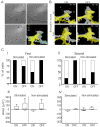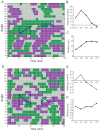Infrared Laser Effects on Cell Projection Depend on Irradiation Intermittence and Cell Activity
- PMID: 36831208
- PMCID: PMC9954793
- DOI: 10.3390/cells12040540
Infrared Laser Effects on Cell Projection Depend on Irradiation Intermittence and Cell Activity
Abstract
Highly focused near-infrared (NIR) lasers have been used to induce fibroblast and neuron protrusions in a technique called optical guidance. However, little is known about the biochemical and biophysical effects that the laser provokes in the cell and optimal protocols of stimulation have not yet been established. Using intermittent NIR laser radiation and multivariate time series representations of cell leading edge movement, we analyzed the direction and velocity of cell protrusions. We found that the orientation and advance of PC12 neuron phenotype cells and 3T3 fibroblasts protrusions remain after the laser is turned off, but the observed increase in velocity stops when radiation ceases. For an increase in the speed and distance of cell protrusions by NIR laser irradiation, the cell leading edge needs to be advancing prior to the stimulation, and NIR irradiation does not enable the cell to switch between retracting and advancing states. Using timelapse imaging of actin-GFP, we observed that NIR irradiation induces a faster recruitment of actin, promoting filament formation at the induced cell protrusions. These results provide fresh evidence to understand the phenomenon of the optical guidance of cell protrusions.
Keywords: actin; cells projection; optical guidance.
Conflict of interest statement
The authors declare no conflict of interest.
Figures






Similar articles
-
Correlated distribution of actin, myosin, and microtubules at the leading edge of migrating Swiss 3T3 fibroblasts.Cell Motil Cytoskeleton. 1989;14(4):527-43. doi: 10.1002/cm.970140410. Cell Motil Cytoskeleton. 1989. PMID: 2696599
-
The dynamic distribution of fluorescent analogues of actin and myosin in protrusions at the leading edge of migrating Swiss 3T3 fibroblasts.J Cell Biol. 1988 Dec;107(6 Pt 2):2631-45. doi: 10.1083/jcb.107.6.2631. J Cell Biol. 1988. PMID: 3204122 Free PMC article.
-
Effects of near infrared focused laser on the fluorescence of labelled cell membrane.Sci Rep. 2018 Dec 5;8(1):17674. doi: 10.1038/s41598-018-36010-1. Sci Rep. 2018. PMID: 30518772 Free PMC article.
-
How and why does beta-actin mRNA target?Biol Cell. 2005 Jan;97(1):97-110. doi: 10.1042/BC20040063. Biol Cell. 2005. PMID: 15601261 Review.
-
Diversity in motile responses of human neutrophil granulocytes: functional meaning and cytoskeletal basis.Adv Exp Med Biol. 1991;297:23-37. doi: 10.1007/978-1-4899-3629-5_3. Adv Exp Med Biol. 1991. PMID: 1767754 Review.
References
-
- Avila R., Medina-Villalobos N., Tamariz E., Chiu R., Lopez-Marín L.M., Acosta A., Castaño V. Optical tweezers experiments for fibroblast cell growth stimulation; Proceedings of the Biophotonics: Photonic Solutions for Better Health Care IV; Brussels, Belgium. 14–17 April 2014; p. 91291U. - DOI
Publication types
MeSH terms
Substances
LinkOut - more resources
Full Text Sources
Miscellaneous

